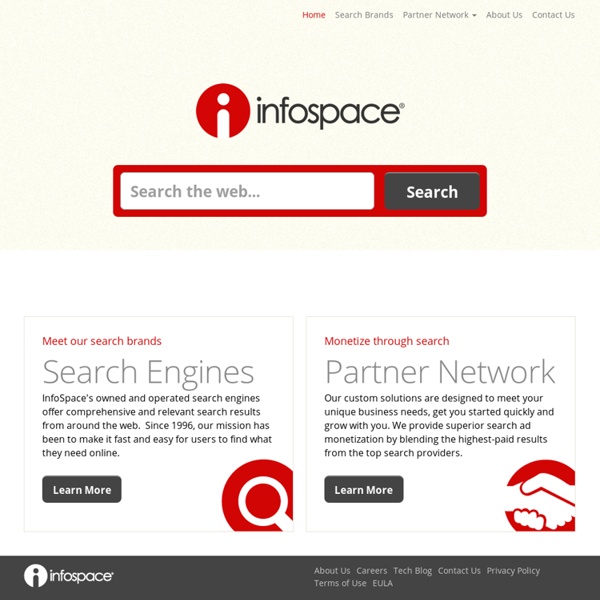



Carrot2 Clustering Engine Carrot2 Search Results Clustering Engine Carrot2 organizes your search results into topics. With an instant overview of what's available, you will quickly find what you're looking for. Choose where to search: Type your query: More options 50 Kick-Ass Websites You Need to Know About It's time to update the entries in your browser's links toolbar. But with recent estimates putting the size of the internet at well more than 100 million distinct websites, it's getting harder and harder to get a handle on all the great stuff that's out there. That's why we've compiled this list. And unlike some lists you may have seen, which try to name the very "best" websites, but end up just telling you a lot of stuff you already know, we've chosen instead to highlight 50 of our favorite sites that fly under most people's radar. Think of it as the Maximum PC blog roll (remember those?). These sites represent great alternatives to popular web destinations like YouTube and Hulu, and include useful references, powerful web apps, and the unknown blogs you must absolutely bookmark.
Twitter Search, Monitoring, & Analytics With iOS 9, Search lets you look for content from the web, your contacts, apps, nearby places, and more. Powered by Siri, Search offers suggestions and updates results as you type. There are two ways to use Search on your iOS device. Quick Search
Future of geo-spatial technology In 2020, the location-based service market is a $1.3 trillion industry.* In 2020, use of geo-location data, including GPS, generates $500 billion in consumer value.** Location Intelligence Applications For Everyone Mapping and Location Analytics for all Imagine the ability to map your data and test hypothesis without the need for a complex and traditionally expensive GIS, combined with the flexibility to do this in the office, at home, at a client location, on the move and even via a tablet device such as iPad. MAPCITE delivers an extremely powerful toolset that has no reliance on your internal IT teams, internal server connections or requires additional software to be installed. Use cases: Chief Constable visualizing officer movement Epidemiologist mapping disease Global tech company anlayzing distribution channels Bank location based transaction analytics Insurer mapping/analyzing fraud locations Health Analyst understanding the "causes of the causes"
Experimental Real-Time Location Tracking Comes To Google Latitude On Android Google has just released a series of updates for their Google Maps Android application. Two of these updates are useful: Place page reviews and the ability to filter search results. But one of them is really interesting: real-time location updating in Google Latitude. To be clear, this feature is an experimental one that Google is trying out. But if you enable it, your friends on the service will be able to see where you are in real-time (and vice versa, if they enable it too). Previously, location updates through Latitude would occur regularly, but not in real-time.
Skip Trace Links Are you looking for someone? This is the place to start! There are many resources available on the Internet to help you find people. You will also find several links below pertaining to collections. 5000+ Resources to Do Just About Anything Online Since May 2007, we've been bringing you resources and tools to be more productive on the web. Due to popular demand, we've brought all these lists together into one gigantic meta-list: 5000+ Resources to Do Just About Anything Online. Enjoy! And don't forget to subscribe to Mashable for the latest web news and resources. 6 Key Ways to Measure Your Blog’s Success - Six essential tools for measuring how your blog is performing. 30+ AJAX-Powered WordPress Plugins - AJAX provides a way to have pages auto-update to reflect new data without page reloads.
Powtoon Login to Powtoon New to Powtoon? Create an account Reset your password Enter your email address and we'll send you a link to reset your password. NIH: Finding and Evaluating Online Resources (Maggie Y. Section 90) What’s the Bottom Line? How much do we know about online resources for complementary health approaches? The number of Web and social media sites, along with mobile apps, offering health information about complementary and integrative health approaches (often called complementary and alternative medicine ) grows every day. What do we know about the accuracy of online health information?